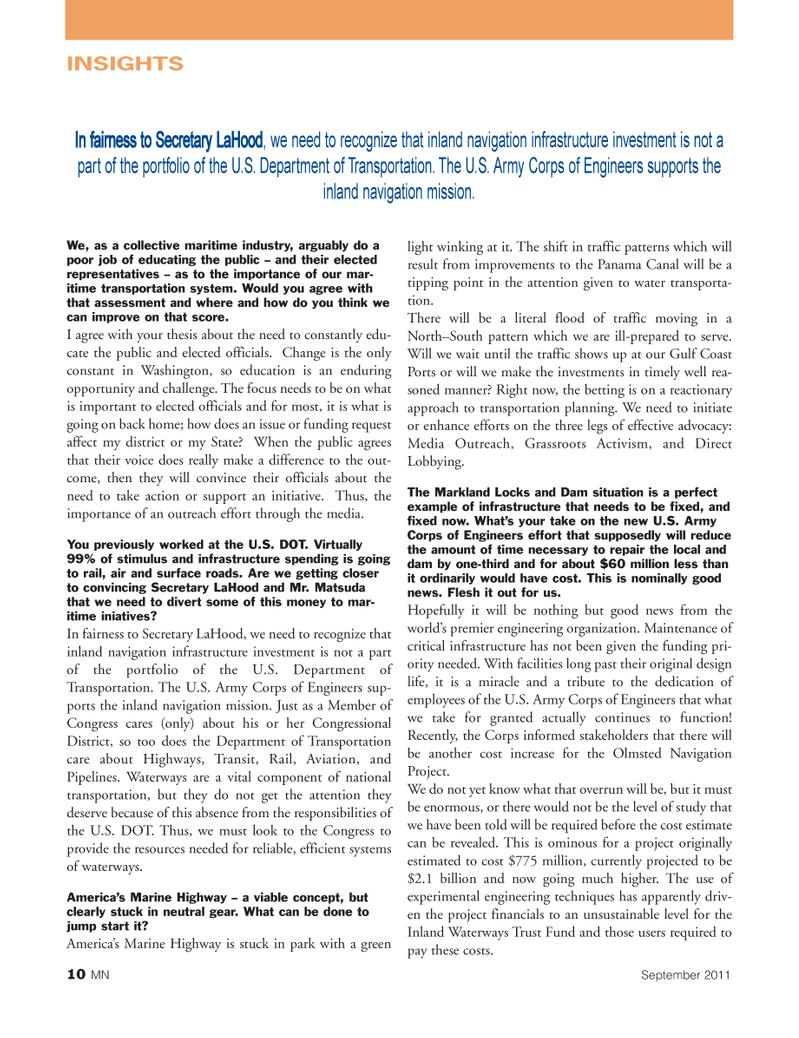
Page 10: of Marine News Magazine (September 2011)
The Environmental Edition
Read this page in Pdf, Flash or Html5 edition of September 2011 Marine News Magazine
We, as a collective maritime industry, arguably do a poor job of educating the public ? and their electedrepresentatives ? as to the importance of our mar- itime transportation system. Would you agree with that assessment and where and how do you think we can improve on that score. I agree with your thesis about the need to constantly edu- cate the public and elected officials. Change is the onlyconstant in Washington, so education is an enduring opportunity and challenge. The focus needs to be on what is important to elected officials and for most, it is what is going on back home; how does an issue or funding request affect my district or my State? When the public agrees that their voice does really make a difference to the out- come, then they will convince their officials about theneed to take action or support an initiative. Thus, the importance of an outreach effort through the media. You previously worked at the U.S. DOT. Virtually 99% of stimulus and infrastructure spending is going to rail, air and surface roads. Are we getting closer to convincing Secretary LaHood and Mr. Matsuda that we need to divert some of this money to mar-itime iniatives?In fairness to Secretary LaHood, we need to recognize that inland navigation infrastructure investment is not a part of the portfolio of the U.S. Department of Transportation. The U.S. Army Corps of Engineers sup- ports the inland navigation mission. Just as a Member of Congress cares (only) about his or her Congressional District, so too does the Department of Transportation care about Highways, Transit, Rail, Aviation, and Pipelines. Waterways are a vital component of national transportation, but they do not get the attention they deserve because of this absence from the responsibilities of the U.S. DOT. Thus, we must look to the Congress to provide the resources needed for reliable, efficient systems of waterways. America?s Marine Highway ? a viable concept, but clearly stuck in neutral gear. What can be done to jump start it?America?s Marine Highway is stuck in park with a green light winking at it. The shift in traffic patterns which will result from improvements to the Panama Canal will be a tipping point in the attention given to water transporta- tion. There will be a literal flood of traffic moving in a North?South pattern which we are ill-prepared to serve. Will we wait until the traffic shows up at our Gulf Coast Ports or will we make the investments in timely well rea- soned manner? Right now, the betting is on a reactionary approach to transportation planning. We need to initiate or enhance efforts on the three legs of effective advocacy: Media Outreach, Grassroots Activism, and Direct Lobbying. The Markland Locks and Dam situation is a perfectexample of infrastructure that needs to be fixed, and fixed now. What?s your take on the new U.S. Army Corps of Engineers effort that supposedly will reduce the amount of time necessary to repair the local and dam by one-third and for about $60 million less than it ordinarily would have cost. This is nominally good news. Flesh it out for us.Hopefully it will be nothing but good news from the world?s premier engineering organization. Maintenance of critical infrastructure has not been given the funding pri- ority needed. With facilities long past their original design life, it is a miracle and a tribute to the dedication ofemployees of the U.S. Army Corps of Engineers that what we take for granted actually continues to function! Recently, the Corps informed stakeholders that there will be another cost increase for the Olmsted Navigation Project. We do not yet know what that overrun will be, but it must be enormous, or there would not be the level of study that we have been told will be required before the cost estimate can be revealed. This is ominous for a project originally estimated to cost $775 million, currently projected to be $2.1 billion and now going much higher. The use of experimental engineering techniques has apparently driv- en the project financials to an unsustainable level for the Inland Waterways Trust Fund and those users required to pay these costs.INSIGHTS10MNSeptember 2011In fairness to Secretary LaHood, we need to recognize that inland navigation infrastructure investment is not a part of the portfolio of the U.S. Department of Transportation. The U.S. Army Corps of Engineers supports the inland navigation mission. MN#9 (1-17):MN 2011 Layouts 9/7/2011 9:25 AM Page 10

 9
9

 11
11
